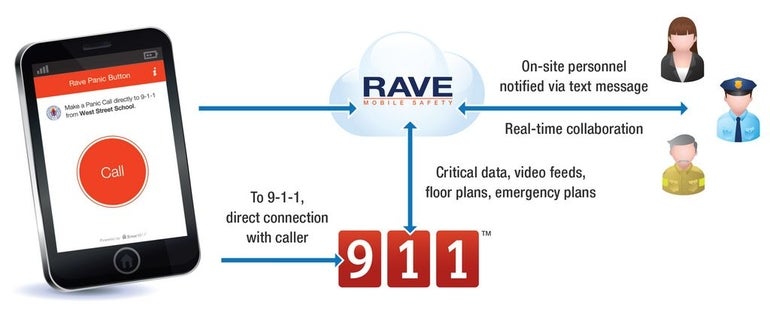Schools adopting Framingham firm's software for safety
 Image courtesy of Rave Mobile Safety
An infographic illustrates how Rave Mobile Safety's new school security app, Rave Panic Button, operates.
Image courtesy of Rave Mobile Safety
An infographic illustrates how Rave Mobile Safety's new school security app, Rave Panic Button, operates.
As school shootings continue to make headlines, public school systems are investing in security systems to make students safer in the Bay State and beyond.
One Framingham company is beginning to make inroads with a new mobile app that gives school officials fast access to public safety, with the click of a cell phone button. Rave Mobile Safety launched its Rave Panic Button mobile software on June 16 - incidentally, about a week after the nation’s latest school shooting in Troutdale, Ore.
Newtown tragedy informed software development
The software has been in the works since the aftermath of the Sandy Hook Elementary School shootings. Officials from Newtown, Conn. met with the company in the spring following the event to discuss how technology could have limited the scope of the tragedy.
Rave Mobile Safety, which until now has worked mostly with municipalities and higher education clients, had been working with Newtown for about a year before the shooting through its Smart911 platform. That software was unrelated to school security and allowed citizens to enter medical history and other personal details to be used in the event of a 9-1-1 call.
The key to school safety, according to Todd Piett, chief product officer at Rave, is connecting people directly involved in an incident to public safety, as the Rave Panic Button does. The system, which can be deployed to all teachers and administrators, uses an app to connect users to designated school and public safety officials.
The user activates an alarm when the button is pressed, but can also send text messages and video. And data about the user’s location, including floor plans, is available to public safety.
“I think everybody is recognizing the problem and investing a ton (of money) in safety,” said Todd Piett of schools systems across the country.
The Milford Public School system is among the first to sign on. Milford Police Chief Tom O’Loughlin said in a statement that, when it goes live in the new school year, the software system will “enable more precise and effective on-site action” in the event of an emergency. In an interview, O’Loughlin said the Rave app is far more affordable than installing an alarm system.
“You basically pay a licensing fee each year,” he said.
O’Loughlin said Milford has been aggressive about improving school security following the Newtown shootings. And he thinks other Massachusetts schools will soon follow Milford’s lead.
Meanwhile, Piett said he expects roughly 500 schools across the U.S. to sign on over the next three to four months. Many school districts are being prompted by state legislation to make these investments, though no formal legislation has yet been passed in Massachusetts.
Piett noted that mobile technology is a smart way to implement an emergency notification system given the attachment to cell phones in our society.
“No one forgets or loses their phone, and if you do, you know it,” Piett said.
Rave is selling the software beyond the Bay State. The Associated Press reported on June 7 that eight school districts in Snohomish County, Washington, are implementing the Panic Button software under a state law requiring Washington public schools to invest in new security and surveillance systems.
The state government in Washington is providing grants to school districts to help pay for the new security measures. A Michigan school district has signed on as well.
U.S. school security varies widely
Historically, U.S. school security has been highly variable, with school districts adopting security policies and systems depending on the resources available and local sentiment. But the many of the nation’s public schools are vulnerable, according to 2010 data published by the National Center for Education Statistics (NCES).
While most school systems (91 percent) lock or monitor doorways, only 46 percent lock or monitor gates on school grounds. Just 5 percent of the nation’s schools employ random sweeps using metal detectors, and only about 1 percent require students to pass through them daily.
Sixty-three percent of schools reported using an electronic notification system for a school-wide emergency in 2010.









0 Comments